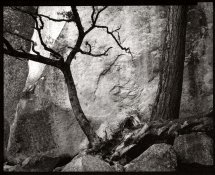LFman
Member
- Joined
- Nov 6, 2011
- Messages
- 42
- Format
- Large Format
Hello all!
I tried my first two platinum (Na2)/palladium prints a couple of days ago. After 30 mins in a plate burner, the excess coating on the paper was a nice, rich black, but the black areas in the print (from under the (in-camera) 4x5 neg) were not. The negative is fairly dense. If it helps, I could probably scan the results in a couple of days.
Does this mean I should use more Na2, maybe make a digital neg with appropriate curves, expose for longer, or perhaps a combination? Could my old UV tubes be too weak from age?
For reference: 6 drops of palladium, 6 drops of ferric oxalate #1, 2 drops of Na2 platinum (5%), coated with glass rod over almost an 8x10 area on Arches watercolour cotton paper. Exposed in an old plate burner (maybe from the 50s!) for 30 mins (after a 10min exposure was way too light). Normal developing with ammonium citrate for 2 mins, quick wash, clearing with EDTA for 5 mins and another wash. All chemistry is about a year old from B&S, but only just opened/mixed a couple of days ago.
Many thanks for your wonderful insights!
I tried my first two platinum (Na2)/palladium prints a couple of days ago. After 30 mins in a plate burner, the excess coating on the paper was a nice, rich black, but the black areas in the print (from under the (in-camera) 4x5 neg) were not. The negative is fairly dense. If it helps, I could probably scan the results in a couple of days.
Does this mean I should use more Na2, maybe make a digital neg with appropriate curves, expose for longer, or perhaps a combination? Could my old UV tubes be too weak from age?
For reference: 6 drops of palladium, 6 drops of ferric oxalate #1, 2 drops of Na2 platinum (5%), coated with glass rod over almost an 8x10 area on Arches watercolour cotton paper. Exposed in an old plate burner (maybe from the 50s!) for 30 mins (after a 10min exposure was way too light). Normal developing with ammonium citrate for 2 mins, quick wash, clearing with EDTA for 5 mins and another wash. All chemistry is about a year old from B&S, but only just opened/mixed a couple of days ago.
Many thanks for your wonderful insights!




